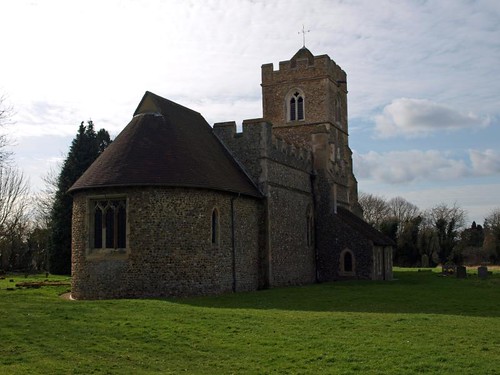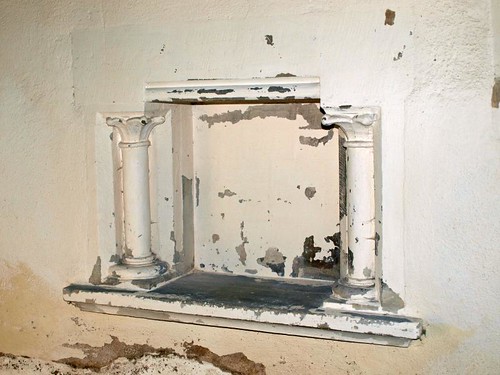ST MARY. Small flint and stone church. Its most remarkable feature is its apsidal chancel. Nave and chancel are Norman as proved by the S doorway (colonnettes with rudely carved faces on capitals, star ornament of the abaci, and star ornament all over the tympanum) and the chancel arch (shafts with primitive volutes at the angle of the capitals). The Double Piscina also has waterleaf capitals. The windows are C13 lancets (chancel) and C14 and C15 designs in the nave. The W tower with diagonal buttresses and a pyramid roof behind the battlements is C15. The nave roof also belongs to the C15. It rests on primitive head corbels.
Great Wymondley. Facing a row of thatched cottages is Delamere House with three storeys rising to Elizabethan gables. But there was a finer house here before it, where Cardinal Wolsey entertained Henry VIII. Great Wymondley indeed had a permanent link with the kings of England, for the lord of the manor, who lived in the timbered 16th-century house to the north-west of the church, held the right to be cupbearer at their coronation.
If Wolsey did not hear mass in his private chapel, he must have gone to this ancient village church which was here so long before him and has so long survived him. In imagination we may follow him in his red cardinal’s robe past the pond and up the green slope to his church where Roman tiles dot the flint walls built by the Normans. The Norman work is also well shown in the apse, the round windows, and the arch of the chancel, while their humour looks out from the sharp-featured faces on the capitals of the doorway with its starry tympanum. On the south wall is scratched an ancient sundial.
Supporting the 500-year-old roof of the nave is a medieval portrait gallery in stone scowling barons, a king, a patient nun, and women in curious square headdresses, a shaggy lion among them resembling the beasts on the 15th-century tower. The plain font and a few of the patched benches were made 500 years ago, and one of the bells is old enough to have tolled for Queen Elizabeth I. Steps inside the wall lead to the vanished roodloft, and on one side of the Norman chancel arch is a peephole to the altar.
The ground falls away behind the church, where is the mound of a fortified enclosure which covered five acres in Wolsey’s day. Beyond it lived a Roman farmer who sowed pottery, tiles, and coins for our own generation to harvest. The farmer probably built the rich villa buried a mile or so away on the bank of the River Purwell, where an almost perfect tessellated pavement was found half a century ago. Still older inhabitants raised their huts beside the lake which then covered this valley, and their flint knives and scrapers prove that Great Wymondley was a village even in the Stone Age.
If Wolsey did not hear mass in his private chapel, he must have gone to this ancient village church which was here so long before him and has so long survived him. In imagination we may follow him in his red cardinal’s robe past the pond and up the green slope to his church where Roman tiles dot the flint walls built by the Normans. The Norman work is also well shown in the apse, the round windows, and the arch of the chancel, while their humour looks out from the sharp-featured faces on the capitals of the doorway with its starry tympanum. On the south wall is scratched an ancient sundial.
Supporting the 500-year-old roof of the nave is a medieval portrait gallery in stone scowling barons, a king, a patient nun, and women in curious square headdresses, a shaggy lion among them resembling the beasts on the 15th-century tower. The plain font and a few of the patched benches were made 500 years ago, and one of the bells is old enough to have tolled for Queen Elizabeth I. Steps inside the wall lead to the vanished roodloft, and on one side of the Norman chancel arch is a peephole to the altar.
The ground falls away behind the church, where is the mound of a fortified enclosure which covered five acres in Wolsey’s day. Beyond it lived a Roman farmer who sowed pottery, tiles, and coins for our own generation to harvest. The farmer probably built the rich villa buried a mile or so away on the bank of the River Purwell, where an almost perfect tessellated pavement was found half a century ago. Still older inhabitants raised their huts beside the lake which then covered this valley, and their flint knives and scrapers prove that Great Wymondley was a village even in the Stone Age.



No comments:
Post a Comment